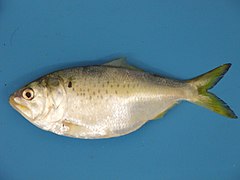Gulf menhaden
| Gulf menhaden | |
|---|---|
 |
|
| Gulf menhaden (Brevoortia patronus), captured in Galveston Bay, TX | |
| Scientific classification | |
| Kingdom: | Animalia |
| Phylum: | Chordata |
| Class: | Actinopterygii |
| Order: | Clupeiformes |
| Family: | Clupeidae |
| Subfamily: | Alosinae |
| Genus: | Brevoortia |
| Species: | B. patronus |
| Binomial name | |
|
Brevoortia patronus Goode, 1878 |
|
The Gulf menhaden (Brevoortia patronus) is a small marine filter-feeding fish belonging to the family Clupeidae. The range of Gulf menhaden encompasses the entirety of the Gulf of Mexico nearshore waters, with the exception of the extreme eastern Yucatan and western Cuba. Evidence from morphology and DNA analyses suggest that the Gulf menhaden is the Gulf of Mexico complement to the Atlantic menhaden (Brevoortia tyrannus). Both species support large commercial reduction fisheries, with Gulf menhaden supporting the second largest fishery, by weight, in the United States.
The Gulf menhaden occurs throughout the Gulf of Mexico, but its distribution is patchy. The center of distribution of the species appears to be the northwest/northcentral Gulf, particularly in Louisiana and Texas where populations are very large and numerous. In the southern Gulf of Mexico the range of Gulf menhaden overlaps that of the closely related finescale menhaden (Brevoortia gunteri), and there is evidence for resource partitioning (a process whereby closely related species occurring in close proximity results in subtle differences in ecological niches) between these species. In the eastern Gulf, the range of Gulf menhaden overlaps that of the yellowfin menhaden (Brevoortia smithi), and hybridization between these species has been demonstrated using morphological and DNA evidence. Gulf menhaden also may have a presence on the southern Atlantic coast of Florida, although this finding is based primarily upon DNA evidence.
Gulf menhaden are commonly 8 inches in length but can reach 12 inches. Gulf menhaden are a dull silver with a greenish back. Like their Atlantic counterpart, Gulf menhaden have a prominent black spot found behind the gill cover followed by a row of smaller spots
Gulf menhaden are filter feeders, meaning that they collect food by filtering water through modifications of the branchial apparatus (gill or branchial arches and gill rakers). Like Atlantic menhaden, Gulf menhaden’s diet depends on the size of their gill rakers, which change as menhaden age. When the rakers are smaller, which generally correspond to when they are under the age of 1, Gulf menhaden feed primarily on phytoplankton. As they age and their gill rakers grow larger, menhaden shift their diet to primarily consume zooplankton.
...
Wikipedia

